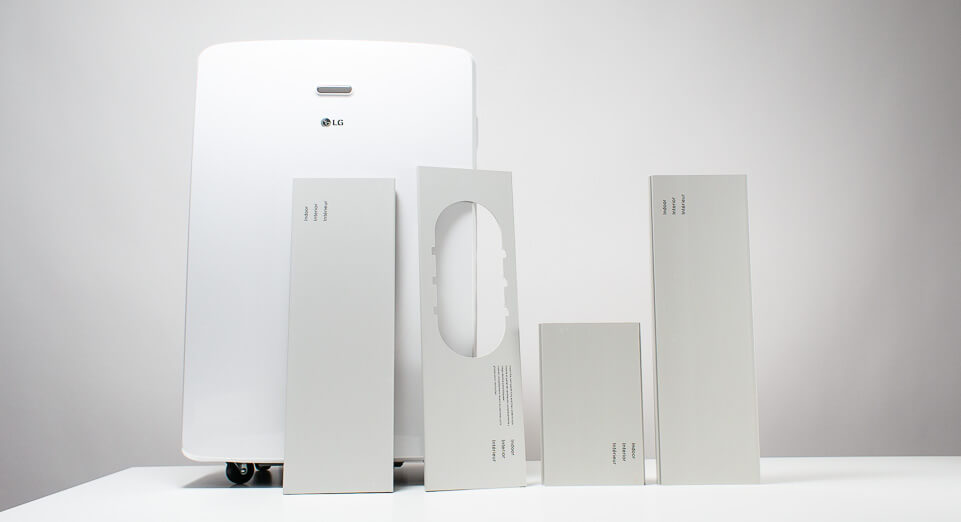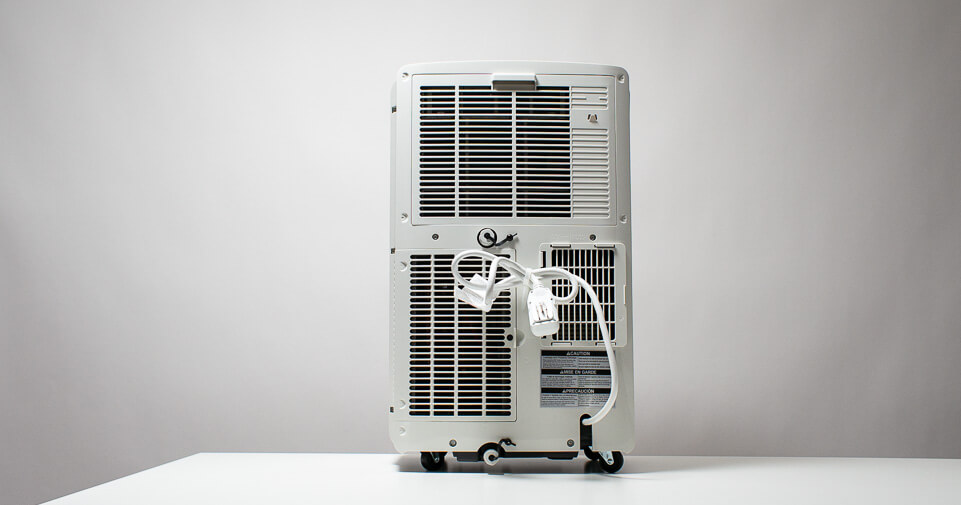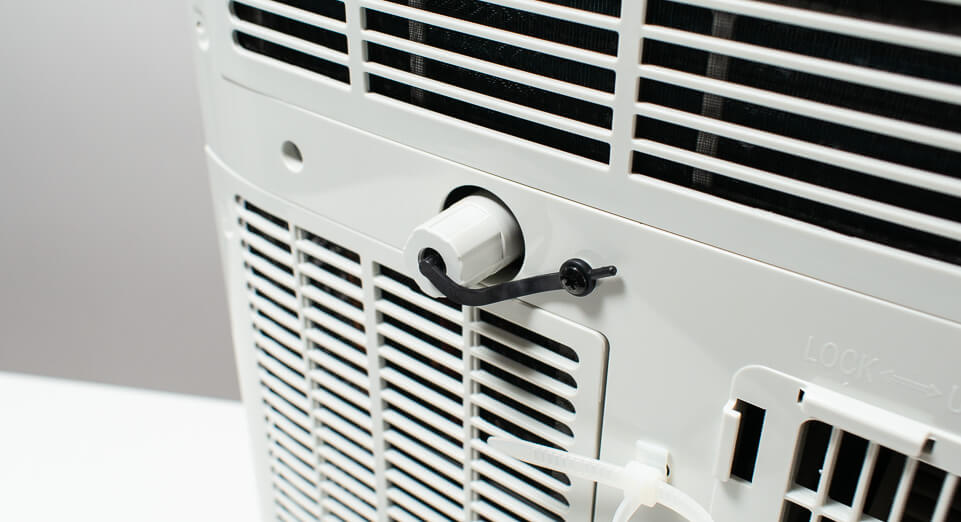LG SR Series Review

This review covers all SR series LG portable air conditioners:
- LP0817WSR
- LP1017WSR
- LP1217GSR
- LP1417SHR
- LP1417GSR
- LP1417WSRSM
All units look like and share many of the same features and functionality as the LP1017WSR - the unit we tested for this review. See the slideshow below.
















Next, let’s go over each specific feature all of the models listed above have in common. We'll end this review by looking at each specific feature they don't have in common.
Window Kit
All models come with the same window kit
Window Kit Included Parts –
primary window bracket (A)
short extension (B)
long extension 1 (C),
long extension 2 (D)
security bracket
2x type A screws (for securing window bracket extensions to window bracket - 1 screw per extension)
1x type B screw (for security bracket)
1x type C screw (for securing exhaust hose window side to window bracket)
Window Kit Bracket Lengths -
A = 18", B= 9", C, D = 17 5/16" -note that C,D are supposed to be 17" according to manual
Window Kit Adjustment – holes in primary bracket are 3/4" apart
Window Kit Minimum Length – 18 1/32”
Window Kit Maximum Length – approx. 59”
Weather Stripping Included –
2x type A foam seals (adhesive)
1x type B foam seal (non-adhesive)
2x type C foam seals (adhesive, shorter version of type A)
Notes
These models come with one of the most extensive window kits on the market. Most portable AC units come with a primary window bracket and a single extension. These models come with a primary window bracket and three extensions.
This allows for
- A lower minimum window size
- A higher maximum window size
- More flexibility to fit the kit properly into all window sizes in-between
These models also come with an extensive weather stripping kit. Most other portable AC units come with only three pieces in the kit or none at all. These LG models come with five pieces in the kit.
This allows you to
- Better seal air gaps around the window bracket and extensions.
- Better seal the air gap between the moving part of the window and the static part of the window.
Hose Connectors
All models come with a similar setup for connecting ducting (a hose) from the AC unit to the window bracket
End Adapters – not pre-installed and difficult to install
You have to install the AC side hose adapter by pulling the hose into the adapter with pliers - a lot of force and maneuvering is required to do so. And there’s no photo or illustration in the manual to better show how to do it correctly.
You have to install the window side hose adapter by first unscrewing the grille over the adapter. Then you have to pull the hose through the adapter (like above). And finally you have to reinstall grille.
AC Side Hose Connection - simple enough - just slide in - but a lot of force is required to put it in and remove it
Window Kit Side Hose Connection - push into window kit bracket and then push to side then secure with single screw directly into plastic
Hose Min/Max – 17.5" to 52.5"
Notes
Most other portable AC units come with end adapters pre-installed on their ducting. This is not the case with these LG models. And it’s very difficult to do (as we described above).
Connecting the ducting (with adapters installed) to the AC unit itself and the window kit is also a bit more difficult with these models than it is with most other portable AC units on the market.
Finally, the duct length is slightly shorter than it is for most other models on the market. For example, the LG LP1419IVSM and NewAir NAC14KWH02 both have a maximum hose length of 62” – about 10” more than the maximum length of the hose for these particular LG models.
Control
All models essentially come with the same control panel and accompanying functionality
Modes – cool, dry (dehumidifier mode), fan
Set temp range - 60 to 86° F
Fan speeds - 2 - hi/low only
Timer - yes, only via remote though - can be set from 0 to 24 hr in 1hr increments
Control panel ights turn off – no
Notes
These LG models feature the same three modes as every other portable AC unit on the market – cool, dry, and fan. The set temperature range is also very similar to that of most other models.
The one unique feature here is the fact that these LG models can only be set to two different fan speeds. Most other portable AC units can be set to three different fan speeds.
This isn’t much of a negative though as you’ll almost always want to set the unit to maximum fan speed. Only on maximum fan speed does the air noise drown out the much harsher buzzing noise of the unit’s compressor.
Condensate
All models can be used as dehumidifiers although exact output varies
Dehumidifier mode pints/day – varies
Drainage options - top and bottom drain plug
Drain hose – included with heating models only
Notes
Moisture removal rate on dry mode varies according to model. In general, the higher the BTUs, the higher the pints/day
Model - pints/day
LG LP1417GSR - 74
LG LP1217GSR - 62
LG LP1017WSR - 60
LG LP0817WSR - 43
These numbers are significantly lower than those of competitors in the same BTU class. For example, in the 14,000 BTU class, the LG LP1419IVSM and NewAir NAC14KWH02 remove 163 and 117 pints/day, respectively. The LG LP1417GSR only removes 74 pints/day.
If it’s a priority for you that your portable AC unit can also be used a dehumidifier, we would advise you to steer clear of this particular line of LG portable AC units.
Filters
All models feature a similar filtration setup
Top filter (evaporator) – just unclips (no screws)
Very easy to remove the grille and the filter from the grille. It’s easy to do because the filter frame plastic is very flexible (not rigid).
Bottom filter (condenser) – same as above
Notes
Some portable AC units (like Honeywell HL-CES units, for example) come equipped with a condenser grille that’s secured with a screw. For such units you have to use a screwdriver to perform basic maintenance like cleaning the unit’s air filters (something that the manufacturer recommends you do once every two weeks).
So far, there’s one major positive for these LG models:
Well above average versatility for window installation – 4 included window kit pieces is more than any other unit we tested.
There’s also one major negative, although you’ll only need to deal with this once when you first setup the unit:
Hose end adapters are not pre-installed and are difficult to install.
Unique Features
Again, this review covers six different LG models:
- LP0817WSR
- LP1017WSR
- LP1217GSR
- LP1417SHR
- LP1417GSR
- LP1417WSRSM
So far, we’ve covered features that these units mostly have in common.
Next, let’s take a look at features they definitely don’t have in common, starting with the most important feature of them all – cooling capacity.
Cooling Capacity
Note how each of the model numbers above start with “LP” followed by four numbers.
The last two numbers signify the year these models were released – ’17.
The first two numbers signify their cooling capacity. For example, the LP0817WSR is an 8,000 BTU portable AC unit.
Thus, the models above fall into four different BTU classes
- 8,000 BTUs
- 10,000 BTUs
- 12,000 BTUs
- 14,000 BTUs
Here’s the problem – the method by which they garnered these BTU numbers is slowly being replaced by a new method for calculating BTUs.
This new method involves accounting for
- the heat the portable AC unit adds back into the conditioned room through its ducting
- the heat the unit adds back into the conditioned room when it creates an area of low pressure inside the room which causes hot outdoor air to want to get pulled into the room (for more detailed analysis see here)
This new method for calculating BTUs results in what is called a seasonally adjusted cooling capacity – SACC for short.
The LP0817WSR is an 8,000 BTU portable AC unit (by old testing methods) but it has a SACC of only 5,500 BTUs. Once its inefficiencies are accounted for (heat added by ducting and infiltration air) it essentially loses 2,500 BTUs of cooling capacity (8,000 – 5,500 = 2,500).
The same drop in BTUs occurs for every single portable AC unit on the market when going from the old method for calculating BTUs to the new method (that involves calculating SACC).
The only question is – what is the extent of the drop? Certain models drop more than others. Those that drop the most are the least efficient (lose the most heat via ducting/infiltration air) and those that drop the least or the most efficient.
Across the board, the LG models that are the subject of this review do fairly well, especially in the lower BTU classes.

Important Note
This particular review was written several years ago. As such, certain models referenced in this review may no longer be available and/or the specific models we recommend may have changed. See our general portable AC buyer's guide for our latest recommendations.
In the 8,000 BTU class, the LP0817WSR’s SACC of 5,500 BTUs is the highest in the category. The Frigidaire FFPA0822U1, for example, has a SACC of only 4,400 BTUs. The Honeywell MO08CESWK has a SACC of only 4,000 BTUs.
In the 10,000 BTU class, the LG LP1017WSR’s SACC of 6,500 BTUs is also the highest in the category. The least efficient units in this class again include Honeywell models - the Honeywell HL10CESWK and MN10CESBB each have a SACC of only 5,500 BTUs.
In the 12,000 BTU class, the LG LP1217GSR’s SACC of 7,000 BTUs is good for second highest in the category. The most efficient 12,000 BTU unit is the Frigidaire FGPC1244T1 with a SACC of 7,200 BTUs – only 200 BTUs more than that of the LG.
The 14,000 BTU class is the only category in which we see these LG models perform poorly compared to the competition. The LG LP1417GSR has a SACC of only 8,000 BTUs. The best performing model in the category is also an LG but a brand new LG in a different line of portable AC units – the LG LP1419IVSM. It has a SACC of 10,000 BTUs. This is the highest recorded SACC of any portable AC unit currently on the market.
All in all, the following models have great cooling capacity for their size class and get our strong recommendation in each respective category because of it:
- LP0817WSR
- LP1017WSR
- LP1217GSR
The following models exhibit a lackluster cooling capacity and are generally not recommended because of it:
- LP1417SHR
- LP1417GSR
- LP1417WSRSM
Energy Efficiency
To calculate a portable AC unit’s energy efficiency, simply divide its SACC by its manufacturer specified power draw.
In doing so, you’ll find that units with a high SACC for their BTU size category (8,000, 10,000, etc. BTUs) tend to have good energy efficiency. Units that have a low SACC do not.
As such, the following models exhibit good energy efficiency
- LP0817WSR
- LP1017WSR
- LP1217GSR
And the following models do not
- LP1417SHR
- LP1417GSR
- LP1417WSRSM
Other Features
We haven’t discussed
- Weight and size
- Noise output
In this review.
We didn’t do so for a reason: all portable AC units, including these LG models, are large and heavy appliances.
And all portable AC units, including these LG models, have to be set to maximum fan speed to drown out compressor noise and on this high fan speed they do make a lot of noise. It’s a clean air noise. But it’s at a high decibel level nonetheless.
Add a Comment
Have a question or comment? Let us know below.

Comments